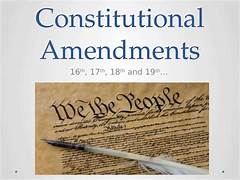Analysis of Key Amendments to the U.S. Constitution
The U.S. Constitution, adopted in 1787, is a foundational document that outlines the framework of the federal government. Over time, it has been amended to address evolving societal needs, protect civil liberties, and refine governance structures. This article explores the most impactful amendments, highlighting their historical context, key provisions, and significance.
The Bill of Rights (Amendments 1-10)
The first ten amendments, collectively known as the Bill of Rights, were ratified in 1791. They were introduced to address concerns about the federal government’s potential overreach and to ensure protection of individual liberties.
First Amendment
The First Amendment guarantees freedoms concerning religion, expression, assembly, and the right to petition the government. It ensures:
- Freedom of speech and the press.
- Protection against government establishment of religion (Establishment Clause).
- The free exercise of religion.
This amendment has been pivotal in shaping American democracy, safeguarding dissent, and ensuring a vibrant public discourse.
Fourth Amendment
The Fourth Amendment protects citizens from unreasonable searches and seizures. It requires:
- Warrants to be issued based on probable cause.
- Specificity in describing the place to be searched and items to be seized.
This amendment underscores the principle of privacy and limits government intrusion, a concept continually tested in modern contexts like digital surveillance.
The Reconstruction Amendments (Amendments 13-15)
Following the Civil War, the Reconstruction Amendments were introduced to address the abolition of slavery and the integration of formerly enslaved individuals into American society.
Thirteenth Amendment
Ratified in 1865, this amendment abolished slavery and involuntary servitude, except as punishment for a crime. It was a monumental step in ending centuries of systemic oppression and laid the foundation for further civil rights advancements.
Fourteenth Amendment
Ratified in 1868, the Fourteenth Amendment provides:
- Citizenship to all persons born or naturalized in the U.S.
- Equal protection under the law.
- Due process rights.
This amendment has been instrumental in numerous landmark Supreme Court cases, including Brown v. Board of Education (1954), which desegregated public schools, and Roe v. Wade (1973), which addressed reproductive rights.
Fifteenth Amendment
Ratified in 1870, this amendment prohibits denying a citizen the right to vote based on race, color, or previous condition of servitude. While significant, its enforcement faced challenges due to discriminatory practices like literacy tests and poll taxes, which were later addressed by the Voting Rights Act of 1965.
Progressive Era Amendments (Amendments 16-19)
The Progressive Era (1890s-1920s) saw amendments aimed at addressing economic inequality, government accountability, and social reforms.
Sixteenth Amendment
Ratified in 1913, this amendment established Congress’s authority to levy an income tax. It provided a steady revenue stream for the federal government, enabling expanded public services and infrastructure projects.
Seventeenth Amendment
Also ratified in 1913, the Seventeenth Amendment mandated the direct election of U.S. Senators by voters, replacing their selection by state legislatures. This change increased democratic participation and reduced corruption.
Eighteenth Amendment
Ratified in 1919, this amendment prohibited the manufacture, sale, and transportation of alcoholic beverages, initiating Prohibition. While intended to address social issues, Prohibition led to unintended consequences, including organized crime, and was repealed by the Twenty-first Amendment in 1933.
Nineteenth Amendment
Ratified in 1920, the Nineteenth Amendment granted women the right to vote, marking a significant victory for the suffragist movement. It underscored the ongoing struggle for gender equality in American society.
Modern Civil Rights and Governance Amendments
Twenty-fourth Amendment
Ratified in 1964, this amendment abolished poll taxes in federal elections, removing a significant barrier to voting for African Americans and low-income individuals.
Twenty-sixth Amendment
Ratified in 1971, the Twenty-sixth Amendment lowered the voting age from 21 to 18. It reflected societal recognition of the contributions and sacrifices of younger Americans, particularly during the Vietnam War.
Structural and Procedural Amendments
Twelfth Amendment
Ratified in 1804, this amendment refined the Electoral College process for electing the president and vice president. It addressed issues exposed in the election of 1800, ensuring clearer procedures for resolving electoral disputes.
Twenty-second Amendment
Ratified in 1951, the Twenty-second Amendment limits the president to two terms in office. This amendment was a response to Franklin D. Roosevelt’s unprecedented four-term presidency and aimed to preserve the principle of democratic rotation in leadership.
Twenty-fifth Amendment
Ratified in 1967, the Twenty-fifth Amendment clarifies presidential succession and procedures for addressing presidential incapacity. It has been invoked in scenarios ranging from temporary transfers of power during medical procedures to considerations of permanent incapacity.
Challenges and Future Considerations
While the U.S. Constitution’s amendments reflect significant progress, challenges remain. Issues like voting rights, campaign finance, and equal representation in the Senate continue to spark debate. Calls for potential new amendments—such as addressing climate change, digital privacy, and term limits for Supreme Court justices—highlight the Constitution’s ongoing evolution.
Conclusion
The amendments to the U.S. Constitution serve as milestones in the nation’s journey toward a more inclusive and just society. Each amendment reflects the struggles and aspirations of its time, underscoring the importance of adaptability in governance. By analyzing these amendments, we gain a deeper understanding of the nation’s legal and social fabric, as well as the enduring pursuit of a more perfect union.


